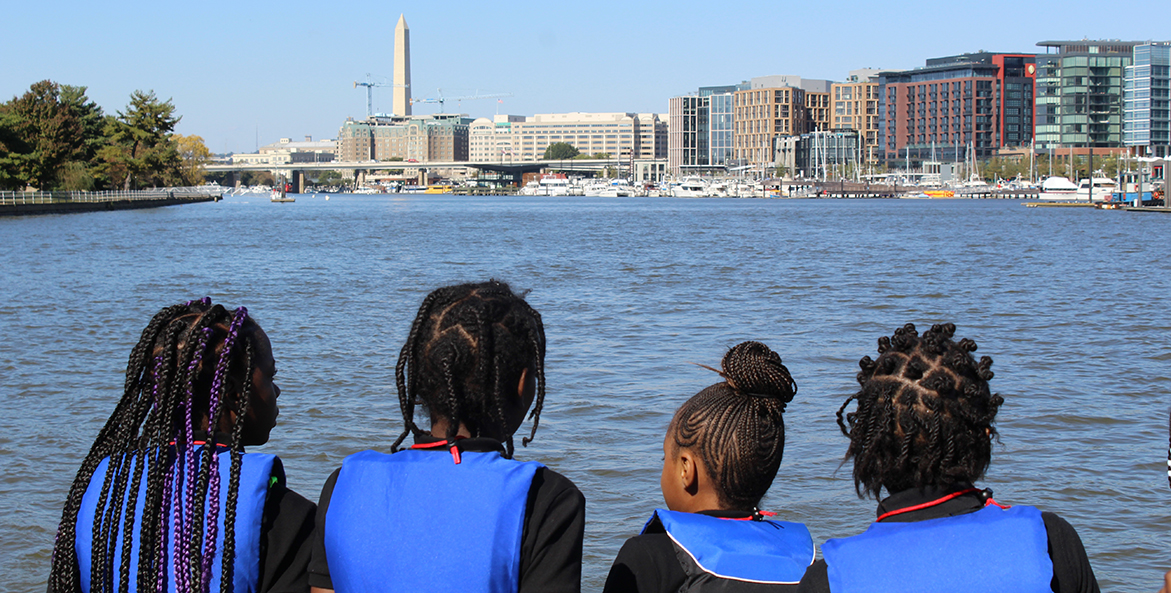As part of our Chesapeake Classrooms professional learning program, we're offering timely new courses for teachers focused on the intersection of two of the most important issues we face today—protecting the environment and advancing social justice.
D.C. Urban Outreach Educator Alexis Dickerson is conducting three courses this summer for teachers about how classes that focus on investigating natural systems can help students, schools, and their communities create change for a greener, more equitable future.
CBF sees teachers as “gardeners” who can plant the seed of environmental stewardship with hundreds, even thousands, of students over the course of their careers. Our goal is to help them inspire students to form a personal connection with the natural world around them. In this way, teachers can create a legacy of community advocacy and caring about the Bay that benefits us all well into the future.
Q. Why is CBF offering these courses?
Alexis Dickerson: If you look around the watershed, you’ll see that unhealthy air and water pollution is disproportionately concentrated in urban areas. These are also areas where most of the watershed’s vulnerable, underrepresented populations live. That’s no coincidence. What we’re trying to do is empower students to better understand why this is and what it takes to create change around them. We start by empowering teachers, so they understand how to bring issues at the intersection of the environment and injustice into the classroom. When they do, they can equip their students to become the next generation of advocates in their communities.
Q. What makes these courses different?
AD: We’re very focused on making the course hyper-relevant to teachers. While we always focus on watershed issues, we are being more intentional in this course about explicitly discussing issues of equity and justice and making sure all of the voices in the watershed are being heard.
Q. How do these courses fit into CBF’s larger mission?
AD: At CBF, we’re in the business of helping people fall in love with the natural world. When teachers do, they can pass that love of nature on to their students and inspire them protect it. But students need to feel a personal connection to where they live before they care about protecting their communities. We work with teachers to help their students forge that connection.
Many people think that cities and the environment are somehow in opposition, but cities are places where nature is happening. They are full of living ecosystems. People don’t see nature in their midst because they don’t know where to look or how to look for it. Our work with teachers enables them to help their students see the “invisible” natural world around them and understand how they are connected to those ecosystems. The more students understand and connect with that world, the more they’ll want to protect it.
Q. What will the courses cover?
AD: The issues we cover in other courses already have a justice component to them, so we’re just elevating that aspect of the conversation to focus on how the health of the Bay watershed is affected by injustice. For example, we will be looking at the investigative questions: How have historical land-use, housing policy, and industry affected the Anacostia River and the communities living along the river? And how can cultivating environmental literacy empower students to identify, investigate and imagine solutions to environmental injustice?
Because our classes have always been very experiential and inquiry-based, the challenge now, with the pandemic, is to make sure teachers get outside every day. We’ll hold classes electronically in the morning and afternoon, but the middle of the day will be devoted to self-guided activities to explore injustice in and around their communities and schools. Afternoon sessions will serve as a “community of learning” for teachers, as we share resources, experiences, and how to best bring engaging, relevant environmental learning into virtual and blended classrooms.
Q. What do you hope teachers will get out of them?
AD: Students are watching the world and demanding attention to issues of justice. Our goal is to help teachers bridge the twin challenges of providing justice-focused learning and meaningful virtual learning. Teachers are facing a lot this fall. We hope that our course will help them feel excited about the many ways that they can approach their teaching.
Most of all, we want them to feel supported. We want teachers to understand how environmental equity is central to the lives and well-being of their students. We also want them to know about and use the resources available to bring those issues into their classrooms in dynamic, interdisciplinary ways.
There are still some openings in our courses left this summer including an asynchronous learning opportunity “Watershed Connections” where teachers can learn online about the Bay at their own pace and timing. And we are looking forward to continuing to support our teachers throughout the school year, no matter what the school year holds.

Washington, D.C. Communications & Media Relations Manager, CBF
lcaruso@cbf.org
202-793-4485



